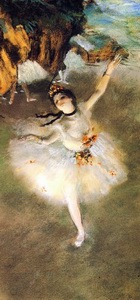
|
 |
德加 (E.Degas 1834-1917)法国画家,印象画派代表人物。在巴黎出生和去世的爱德加·德加是银行家之子.生来便是大资产阶级,他对古典主义的浓厚兴趣和他行为的谨慎似乎与出身十分合拍.不过,他那异常强烈的个性和独立自主的思想却又把他抛入革命阵营.他在美术学院安格尔弟子拉莫特的班级里习画,并且,始终对安格尔极为敬仰.不管他的天才如何演变,他却从不背弃过去.毫无疑问,这种对于人类创造的崇敬,对于行善的明确意识是其性格的基础,也是人们指责他的根源.其画风的演变也比较清楚地表明德加对印象主义采取了一种非常特殊的立场.他的绘画作品都无可争辩地面对着素描严谨、古典之极的艺术.这种手法渐渐地让色彩占据越来越重要的地位.不过,这种色彩始终为现实主义服务.天才的德加赋予它以扩大的视野和独特的画面布局,并永远地离开了学院主义,其作品意义远远超过人们在印象派中给予他的地位。
|

|
